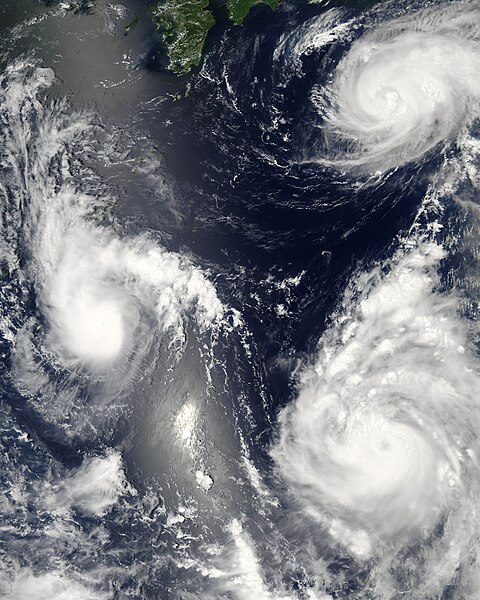ไฟล์:Maria, Bopha and Saomai 2006-08-07 0435Z.jpg

ขนาดของตัวอย่างนี้: 480 × 600 พิกเซล ความละเอียดอื่น: 192 × 240 พิกเซล | 384 × 480 พิกเซล | 614 × 768 พิกเซล | 819 × 1,024 พิกเซล | 1,638 × 2,048 พิกเซล | 7,200 × 9,000 พิกเซล
ดูภาพที่มีความละเอียดสูงกว่า (7,200 × 9,000 พิกเซล, ขนาดไฟล์: 7.6 เมกะไบต์, ชนิดไมม์: image/jpeg)
ประวัติไฟล์
คลิกวันที่/เวลาเพื่อดูไฟล์ที่ปรากฏในขณะนั้น
| วันที่/เวลา | รูปย่อ | ขนาด | ผู้ใช้ | ความเห็น | |
|---|---|---|---|---|---|
| ปัจจุบัน | 10:06, 8 สิงหาคม 2549 |  | 7,200 × 9,000 (7.6 เมกะไบต์) | Good kitty | == Summary == {{Information |Description=Three different typhoons were spinning over the western Pacific Ocean on August 7, 2006, when the Moderate Resolution Imaging Spectroradiometer (MODIS) on NASA’s Aqua satellite acquired this image. The strongest |
หน้าที่มีภาพนี้
หน้าต่อไปนี้ โยงมาที่ภาพนี้:
การใช้ไฟล์ข้ามโครงการ
วิกิอื่นต่อไปนี้ใช้ไฟล์นี้:
- การใช้บน ar.wikipedia.org
- การใช้บน az.wikipedia.org
- การใช้บน bg.wikipedia.org
- การใช้บน bh.wikipedia.org
- การใช้บน crh.wikipedia.org
- การใช้บน cs.wikipedia.org
- การใช้บน de.wikipedia.org
- การใช้บน en.wikipedia.org
- Typhoon
- Typhoon Saomai
- Tropical cyclone
- Wikipedia:Picture peer review/Archives/Archive2006
- User:Plasticup/MyFavorites
- Typhoon Maria (2006)
- User talk:Hurricanehink/Archive 23
- User talk:Thegreatdr/2012archive
- Wikipedia:Wikipedia Signpost/2013-11-20/Traffic report
- Wikipedia:Wikipedia Signpost/Single/2013-11-20
- Wikipedia:Top 25 Report/November 10 to 16, 2013
- User:Tfmbty/2006 Pacific typhoon season
- User:SongdaTalas/Archives of Former Articles
- การใช้บน en.wiktionary.org
- การใช้บน es.wikipedia.org
- การใช้บน fi.wikipedia.org
- การใช้บน hi.wikipedia.org
- การใช้บน id.wiktionary.org
- การใช้บน incubator.wikimedia.org
- การใช้บน ja.wikipedia.org
- การใช้บน ja.wikibooks.org
- การใช้บน ko.wikipedia.org
- การใช้บน lo.wikipedia.org
- การใช้บน ms.wikipedia.org
- การใช้บน my.wikipedia.org
- การใช้บน nn.wikipedia.org
- การใช้บน no.wikipedia.org
- การใช้บน pt.wikipedia.org
- การใช้บน ro.wikipedia.org
- การใช้บน ru.wikipedia.org
- การใช้บน szy.wikipedia.org
- การใช้บน tk.wikipedia.org
- การใช้บน tr.wikipedia.org
- การใช้บน tt.wikipedia.org
- การใช้บน uk.wikipedia.org
- การใช้บน vi.wikipedia.org
ดูการใช้ข้ามโครงการเพิ่มเติมของไฟล์นี้





